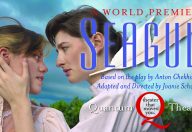‘Killer Heels’ To End Dazzling Nationwide Tour at The Frick Pittsburgh

Christian Louboutin. “Marie-Antoinette,” Fall/Winter 2008-2009. Satin crepe with Lesage embroidery. Courtesy of Christian Louboutin. Photo: Christopher Maggio.
Killer Heels: The Art of the High-Heeled Shoe is on its last stop. The exhibition, which showcases nearly 150 unique heels from circa 1600 to now, is currently at the Frick Art & Historical Center. September 4 marks the last day to see the exhibit not only at The Frick but also anywhere. After that, the nationwide tour, which was curated by the Brooklyn Museum in New York, ends. Then it’s back into the shoebox for these heels.
Why Shoes?
Killer Heels is the first of three fashion-centric exhibitions at The Frick, supported in no small part by a generous $1,000,000 grant awarded by the Richard King Mellon Foundation. The Frick hopes these exhibitions will bolster both attendance and museum membership.
The plan appears to be working. “We have had a tremendous response to this exhibit,” Diane Ott, a docent, said. People who have lived in Pittsburgh all their lives, but who have never frequented The Frick, are coming.
Killer Heels, then, represents the paragon of an effective art exhibition. It uses something with broad appeal, i.e. fashion, as a hook to entertain. As museum goers walk through the exhibit, informative placards and thoughtful curating subtly educate them as well.
This pairing of entertainment and education begins upon entering the Frick Art Museum, an Italian Renaissance-style building on the larger Frick grounds. The building opens to a rotunda, “Revival and Reinterpretation,” the first of Killer Heels’ six thematic sections. Here, shoes in glass cases are spaced evenly around a curved wall.
Patrons are sure to be entertained by the small jeweled belt buckle of a woman’s shoe from approximately 1760-70. But it’s the placard next to this shoe that quickly subsumes all interest. From it, patrons learn this elegantly curved heel is named after King Louis XV, who wore a similarly styled shoe. That’s right, kings wore heels. In fact, men were the first people to wear heels, dating back to soldiers in the Ottoman empire, who used the heels to keep their feet securely in their horses’ stirrups.
As with all fashion, heel design is cyclical. What was once unpopular becomes popular again. The curated physical space—the rotunda—reflects this cyclical nature. As one moves beside the curved wall, the exhibition progresses chronologically, with the heel quickly falling out of style among men. That is, until one stands on the other side of the rotunda, opposite that Louis heel, and face-to-shoe with a sequined platform, like the kind that the late David Bowie would have worn during glam rock’s heyday. The popularity of blaxploitation films like Super Fly also aided in high heels’ resurgence among males in the 1970s.
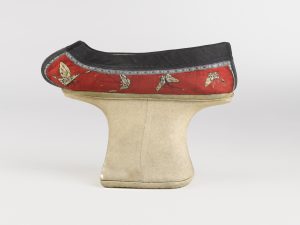
Chinese. Manchu Woman’s Shoe, 19th century. Cotton, embroidered satin-weave silk. Brooklyn Museum, Brooklyn
Museum Collection, 34.1060a, b. Photo: Sarah DeSantis, Brooklyn Museum.
Exiting the rotunda, visitors enter a room with wooden floors and glistening chandeliers. To the left is “Rising in the East,” which further delineates high heels’ origins. Many people may know the bygone Chinese practice of foot binding: girls feet would be bound, all toes broken except the big one, to prevent foot growth. Bound feet signified status and beauty. The Manchu Chinese did not bind their feet; however, they still coveted the walk of a bound foot. Thus was invented a cotton shoe with an inverted platform, one which mimicked this walk. Uncomfortable, yes, but at least the Manchu women could remove them.
Opposite “Rising in the East” is “Glamour and Fetish.” Glass cases of frilly and jeweled high heels quickly give way to cases of thigh-high boots and stilettos that are adorned with laces and rhinestones. On a small screen, a scene from the 1959 comedy Some Like It Hot plays on repeat. The scene depicts Tony Curtis and Jack Lemmon, both dressed in drag, attempting to board a train … with Lemmon nearly falling over his high heels. Curtis and Lemmon are dressed in drag not because of glamour or fetish but rather to hide from mobsters. Still, hearing Lemmon ask, “How do they walk in these things, huh? How do they keep their balance?” reminds the viewer of high heels’ place in the annals of comedy as well as fashion.
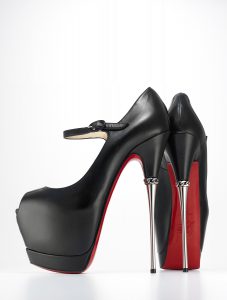
Christian Louboutin. “Printz,” Spring/Summer 2013. Courtesy of Christian Louboutin. Photo: Jay Zukerkorn.
A much different movie plays in a separate room. In Untitled by Steven Klein, the stiletto heel, which takes its name from the stiletto dagger, becomes not an object of amusement but of empowerment. For nearly eight minutes, the observer watches close-up after close-up: a stiletto heel breaks up a small toy car. Most disarming, the wearer, still in her heels, but shown from the legs down only, walks across the muscular, bare chest of a blindfolded, bound man while another man, similarly bound, listens. This film is one of six originals that explores the cultural and aesthetic facets of high heels. The films are shown continuously at the exhibit. The viewing areas are evenly spaced throughout the corridors, an effective use of additional media that does not distract from the physical displays.
Is It Art?
Speaking of aesthetics, I can hear certain readers asking about now: “But is a high heel really art?” (Short answer: Yes. Long answer: I have bought the same pair of black Vans low tops every year as the pair before them wears out, going on four years now, and even I can appreciate and often gasp at the intricacies and nuances of these much more colorfully and wondrously designed shoes.)
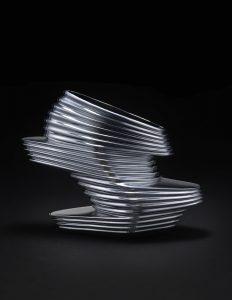
Zaha Hadid X United Nude. “NOVA,” 2013. Chromed vinyl rubber, kid napa leather, fiberglass. Courtesy of United Nude. Photo: Jay Zukerkorn.
Those who want further proof should seek “Architecture,” the fourth section in the exhibition. Nowhere is the connection between art and fashion stronger than in “NOVA,” devised by the late Iraqi architect Zaha Hadid for United Nude, a design company especially known for its high-heeled shoes. Hadid’s heel—constructed from chromed vinyl rubber, kid napa leather, and fiberglass—mirrors the prismatic Library and Learning Centre that she designed for the University of Economics in Vienna.
“Metamorphosis” touches on the ability of high heels, specifically the stiletto, to change the wearer: a person’s legs become longer, calves bigger. For Cinderella, the change brought by her glass slipper was even more profound. Glass heels are displayed at The Frick, but so are heels undergoing their own metamorphoses. One heel resembles a teacup; the other, a human foot, painted toes and all. Still another is sprouting googly eyes. (Note: some of the shoes aren’t meant for walking but for admiring, a fact which may additionally convince skeptics of their aesthetic value.)
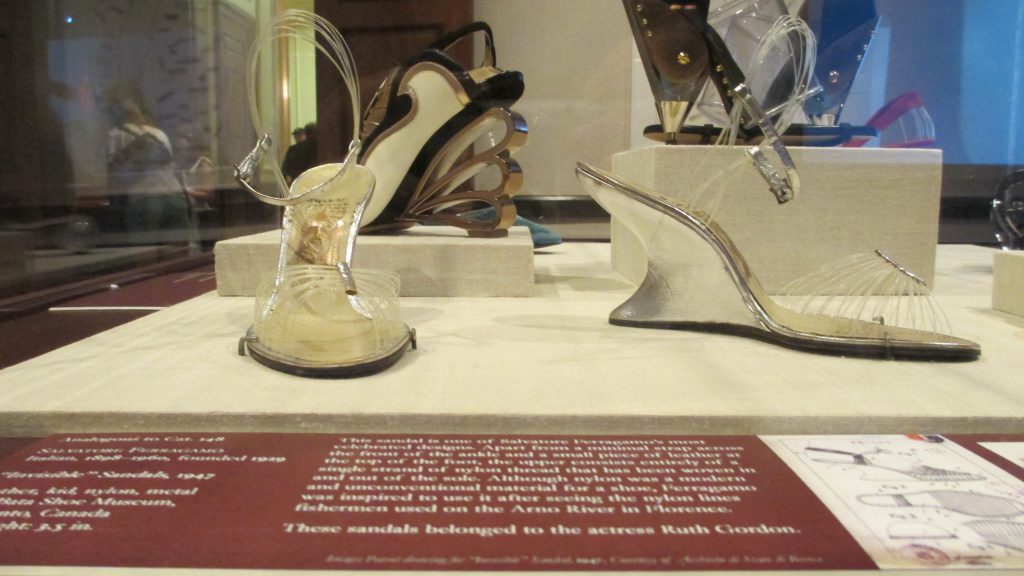
Salvatore Ferragamo. “Invisible Sandals,” 1947. Leather, kid, nylon, metal. The Bata Shoe Museum, Toronto, Canada. Photo: Christopher Maggio.
The exhibition ends with “Spacewalk,” a collection of futuristically designed shoes. The room itself is spacious compared to the tighter, labyrinthine rooms that precede it. Patrons can get their bearings and begin to transition out of Killer Heels. Of particular note is Salvatore Ferragamo’s “Invisible Sandals.” Save a minimal strap and a small piece of leather, the lacy upper of the shoe is composed of a single strand of nylon thread. Ferragamo got the idea after observing Italian fisherman casting nylon lines on Florence’s Arno River.
Killer Heels: The Art of the High-Heeled Shoe is organized by Lisa Small, Curator of Exhibitions at New York City’s Brooklyn Museum. Although the Brooklyn Museum asked that the shoes be maintained within their respective themes, Sarah Hall, the Frick’s Director of Curatorial Affairs, could arrange them how she wanted within those groups.
“I felt pacing was important,” Hall said. “Creating really beautiful and relevant groups of shoes, shoes that connect each other through design, color, shape, all of those things in our display cases, was a real priority.”
Her pacing of the cases succeeds. I did not feel I had looked at shoe after shoe after shoe but rather at a unified whole. I also left the exhibition without museum fatigue, that tiredness one often feels when standing and gazing at artwork for long stretches of time.
Fashion Forward
How will The Frick follow high heels? Why, with underwear, of course. Undressed: A Brief History of Underwear, with loaner pieces from the Victoria & Albert Museum’s undergarments collection, arrives fall 2017. Then in fall 2018 comes Pulp Fashion: The Art of Isabelle de Borchgrave, a Belgian artist who creates paper costumes.
The Frick offers plenty of permanent attractions in between its temporary exhibitions, like Henry Clay Frick’s home, Clayton; the Café; the Car and Carriage Museum; and more. Killer Heels is a good gateway into these permanent attractions. The Frick has more than 2,000 items in its collection that are costume or fashion related, like evening gowns and children’s clothing.
“We really see this as a niche that’s part of our regular program,” Hall said.
Also, The Frick is now open every Friday until 9 p.m. for its Summer Fridays Series, which runs until September 2 and features some form of free entertainment, like live music.
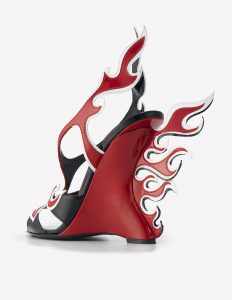
Prada. Wedge Sandal in Rosso, Bianco, and Nero Leather, Spring/Summer 2012. Courtesy of Prada USA Corp. Photo: Jay
Zukerkorn.
As for the shoes in Killer Heels, not all of them are actually going back into boxes September 5. Rather, many will return to the Bata Shoe Museum in Toronto, the Costume Institute at the Met, and various design houses. But unless patrons would prefer accruing frequent flyer miles, they should see these high heels while they are all in one place. It’s a collection that would make Imelda Marcos—wife of the late Philippine dictator Ferdinand Marcos and former owner of over 1,000 pairs of shoes—positively drool.
The Frick Art & Historical Center
Tuesday through Sunday, 10 a.m. – 5 p.m. Friday, 10 a.m. – 9 p.m. Closed Mondays.
7227 Reynolds St., Point Breeze.
(412) 371-0600
Christopher Maggio is a Pittsburgh-based writer and editor and loves Pittsburgh’s neighborhoods.
Share on Social Media
Follow Entertainment Central
Latest Stories
Sign up for the EC Newsletter






